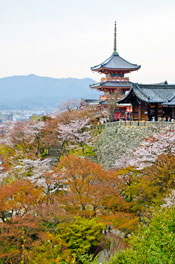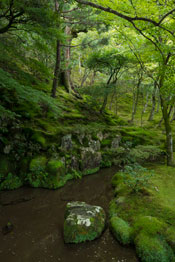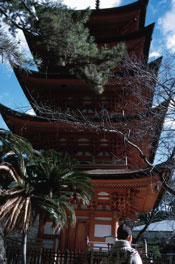
![]() Historic Monuments of Ancient Kyoto -2 (Kyoto, Uji and Otsu Cities)
Historic Monuments of Ancient Kyoto -2 (Kyoto, Uji and Otsu Cities)
Kiyomizu-dera Temple was built by Sakanoue Tamuramaro (758-811), a military commander and Enchin monk, and is one of the best sightseeing places in Kyoto. Among its many interesting features, the most famous is the "Kiyomizu-no-butai (main hall's wooden veranda)". It is supported by 139 pillars and built as though projected on to the mountain slope. It is said that if you jump from this veranda and survive with no injuries, your wishes will be fulfilled and if you die, you will become a peaceful saint. For a long time there seemed to be no end to the people willing to jump from there and in order to stop this phenomenon, the government enacted a law in 1872 to prohibit jumping.
Ryoan-ji Temple is a well known for its "Sekitei" rock garden. There are no ponds or other water features in this garden; natural water scenery is expressed using stones and gravel. The simple forms with lines in white gravel made by sweeping with a broom, and 15 large and small stones set at 5 points, symbolizes formal Japanese beauty, in which all superfluity is eliminated. There is also a bit of playfulness in the design as one of the 15 stones is always hidden behind another stone no matter from which angle the garden is viewed, which fascinates the tourists. By the way, this garden started appearing in overseas mass media after being highly praised by Queen Elizabeth on her visit here. (Japan Tourists Organization)
![]() What did you give to them on their birthday?
What did you give to them on their birthday?
おたんじょうびに なにを あげましたか。(お誕生日に、何を、上げましたか。)
Let's practice more using indirect object marker に. Say what you gave the following people for their birthday last year. Click on the name of the person to see a possible response. Remember that different verbs are used when giving to different people as follows:
あげます(上げます)Is the normal verb used to mean you give to someone else BUT
やります is sometimes used to mean “give” when giving to a younger person or pet that is considered of “lower rank” than the giver
| きょうだい (兄弟) | きょうだいに CDを あげました。 (兄弟に CDを 上げました。) |
| りょうしん(両親) | りょうしんに しを あげました。 (両親に、詩を 上げました。) |
| ともだち(友達) | ともだちに ほんを あげました。(友達に 本を 上げました。) |
| にほんごのせんせい(日本語の先生) | にほんごのせんせいに にほんのほんを あげました。(日本語の先生に、日本の本を 上げました。) |
| おじいさんとおばあさん(御祖父さんと御祖母さん) | そふとそぼに はなをあげました。(祖父と祖母に、花を 上げました。) |
| ガールフレンド / ボーイフレンド | ボーイフレンドに ペンを あげました。(ボーイフレンドに ペンを 上げました。) |
| いぬ(犬) | いぬに ボールを やりました。(犬に ボールを やりました。) |
| いもうと(妹) | いもうとに テニスラケットを やりました。(妹に テニスラケットを やりました。) |
| おかあさん (お母さん) | ははに りょうりのほんを あげました。(母に 料理の本を 上げました。) |
![]() Japanese Fairy Tale おとぎばなし
Japanese Fairy Tale おとぎばなし
“ももたろう (Peach Boy)” is one of the most famous fairy tales in Japan. Like many other fairy tales, it begins with a phrase “むかし、むかし…(Once upon a time…)”.
むかし、むかし、あるところに おじいさんと おばあさんが すんでいました。 昔々、ある所に お爺さんとお婆さんが 住んでいました。 お爺さんは 山に しばかりに お婆さんは 川に せんたくに 行きました。 |
Once upon a time, there was an old man and an old woman. The old man went to a mountain to gather firewood, and the old woman went to a river to wash clothes. |
![]() Okonomiyak
Okonomiyak
Okonomiyaki is a kind of Japanese-style pancake or pizza. The name “okoomi” means “as you like” and “yaki” means “grilled”. You can add your favorite fillings such as pork, beef, chicken, corn, squid, octopus etc. in okonomiyaki. Many okonomiyaki restaurants are set up as “grill-it-yourself” establishments, where the server brings the customer a bowl of ingredients, and the customer then mixes and grills it on their own at a table with a hot plate. Osaka and Hiroshima are well known for their okonomiyaki. This recipe is Kansai (Osaka area) style okonomiyaki. In Hiroshima style, the ingredients including yakisoba are layered.
 Ingredients (for 2 servings):
Ingredients (for 2 servings):
1 cup all purpose flour
¾ cup water (or dashi soup)
1 egg
¼ of small cabbage
Fillings (any of your favorite fillings such as thinly sliced pork, beef or chicken, shrimp , squid or octopus)
Toppings:
Katsuo-bushi (dried bonito flakes)
Beni-shoga (red ginger)
Ao nori (green seaweed)
Okonomiyaki sauce (or tonkatsu sauce)
Mayonnaise
Preparation:
1. Cut cabbage into very thin slices.
2. Beat an egg in a bowl and add water (or dashi soup)
3. Add flour in the bowl and mix well.
4. Add sliced cabbage in the flour mixture and mix.
5. Fry raw fillings (meat/squid/shrimp etc.) in a pan.
6. Cook the flour mixture. Add the cooked fillings on top.
7. Cook for a few minutes and flip pancake and cook for a few more minutes.
8. Put okonomiyaki sauce and mayonnaise over the okonomiyaki.
9. Sprinkle with toppings (katsuobushi flakes, aonori, beni-shoga etc.) on top.
![]() Historic Monuments of Ancient Kyoto -3 (Kyoto, Uji and Otsu Cities)
Historic Monuments of Ancient Kyoto -3 (Kyoto, Uji and Otsu Cities)

There are many other sightseeing points registered as world heritage sites apart from Kiyomizu-dera Temple, Kinkaku-ji Temple and Ryoan-ji Temple, which we have just introduced. For instance, "Saiho-ji Temple" more familiar under its other name of "Koke-dera" because it has a garden covered with Koke (moss).

"Jisho-ji Temple (Ginkaku-ji)"has a beautiful garden representing Higashiyama culture from the mid Muromachi period.
"Ninna-ji Temple" is known for its symmetrical five-story pagoda; "Kyouou Gokoku-ji Temple" (= To-ji) has a spectacle of 21 statues of Buddha expressing Tantric Buddhist ideology; "Enryaku-ji Temple" on Hiei Mountain has more than 200 towers and halls; "Daigo-ji Temple"  built across Mount Daigo has one of the best large-scale temples in Kyoto; "Byodoin" famous for "Amidado" reflects like a floating palace in the water of a pond; "Kozan-ji Temple" is considered the birthplace of Japanese tea and is still filled with tea orchards; a representative temple of the Zen Buddhist School is the"Tenryu-ji Temple"; "Hongan-ji Temple" (= Nishi-honganji) is where various national treasures including the oldest Noh stage in Japan that is preserved; "Kamowakeikazuchi-jinja Shrine" (= Kamigamo-jinja Shrine) has a brilliant vermilion-lacquered gate; "Kamomioya-jinja Shrine" is one of the oldest shrines in Kyoto; "Ujikami-jinja Shrine"has a main hall known as the oldest shrine architecture in Japan; and "Nijo-jo Castle" is where the last Shogun lived and tourists come to view the incredible paintings on sliding screens. All of these heritage sites convey Japanese history and culture and offer many highlights that you should not miss, so it is strongly recommended that you plan your schedule in order to fit in as many places as possible when you visit Kyoto. (Japan Tourists Organization).
built across Mount Daigo has one of the best large-scale temples in Kyoto; "Byodoin" famous for "Amidado" reflects like a floating palace in the water of a pond; "Kozan-ji Temple" is considered the birthplace of Japanese tea and is still filled with tea orchards; a representative temple of the Zen Buddhist School is the"Tenryu-ji Temple"; "Hongan-ji Temple" (= Nishi-honganji) is where various national treasures including the oldest Noh stage in Japan that is preserved; "Kamowakeikazuchi-jinja Shrine" (= Kamigamo-jinja Shrine) has a brilliant vermilion-lacquered gate; "Kamomioya-jinja Shrine" is one of the oldest shrines in Kyoto; "Ujikami-jinja Shrine"has a main hall known as the oldest shrine architecture in Japan; and "Nijo-jo Castle" is where the last Shogun lived and tourists come to view the incredible paintings on sliding screens. All of these heritage sites convey Japanese history and culture and offer many highlights that you should not miss, so it is strongly recommended that you plan your schedule in order to fit in as many places as possible when you visit Kyoto. (Japan Tourists Organization).
![]() Graded Assignments
Graded Assignments
Please return to the Section 3 Tasks & Assignments folder to complete the graded assignments for Section 3, Part B.

